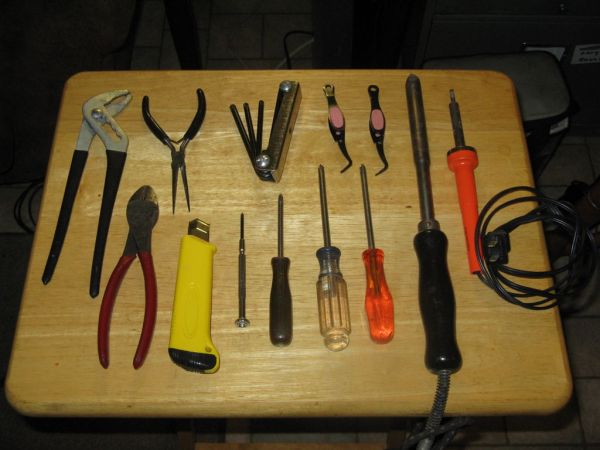Almost all electronics have some sort of human interface, from blinking lights and beeping speakers to seven segment alphanumeric and Liquid Crystal Displays. This Instructable is about salvaging and testing Liquid Crystal Displays, and a couple tricks I know to make salvaging them more successful.

Liquid Crystal Displays can be found on CD players, Phones, and printers just to mention a few. In this Instructable I will be dissembling an HP combination printer, scanner, fax machine.
Step 1: Tools & Supplies
[box color=”#985D00″ bg=”#FFF8CB” font=”verdana” fontsize=”14 ” radius=”20 ” border=”#985D12″ float=”right” head=”Major Components in Project” headbg=”#FFEB70″ headcolor=”#985D00″]
Assorted Phillips Screwdrivers
Assorted Torx Screwdrivers
Assorted Pliers
Side Cutters
Spring Loaded Tweezers
Large Soldering Iron
Small Soldering Iron
Utility Knife
Dremel Set
Arduino UNO Kit
Wires
Solder
Goop Glue
[/box]
Step 2: Disassembling a HP psc 750xi
Printers & scanners are simple to dissemble, just remove the screws and take out the parts most of the screws are under the lid, on the back, and on the bottom of the printer & scanner.
Even when the screws are removed the plastic housing panels are clipped together with tabs holding them in place. Work your way around the individual panels to find the tabs and unclip them. Plastic is recyclable and some plastic recyclers pay for the plastic so don’t just throw the plastic in the garbage.
The control module of the printer scanner contains the control buttons and the Liquid Crystal Display. It dissembles by removing the five screws on the back.
I sort the parts into two groups Electronics to be stripped for parts and gold, and mechanics like guides, gears, and stepper motors.
Remember metal is recyclable and almost all recyclers pay for scrap metal so if you don’t keep it sell it.
Although the LCD module looks different than the other TN STN FSTN LCD modules in this Instructable it is connected the same way when testing.
Step 3: Chip on Glass Liquid Crystal Displays (COG LCD)
Chip on Glass (COG) LCDs have the driver IC on the glass near the input pins or ribbon connector (The rectangle on the glass near the pins & ribbon) and they come in serial data input as well as parallel data input like TN, STN, and FSTN modules. Many of the serial data input COG LCDs have the same number of pins as the parallel data input LCDs, so with COG LCDs the datasheets are more important as the inputs purpose is not easy to see when you are just looking at the LCD.
As well as the attached datasheet here is some pin outs for COG displays, many of the data sheets have the Display in the part number such as, S161COG, 16×1 COG display, S162COG, 16×2 COG display, and 64128L 128×64 graphic LCD display.
The contrast circuit for COG LCDs is the same as the contrast circuit as TN, STN, FSTN module.
Pins Right to Left
8 Pin 16×2 Character COG LCD
PIN SYMBOL FUNCTION
1 VOUT DC/DC Converter Out
2 VC Capacitor Positive (-) side
3 VCC Capacitor Negative (+) side
4 VDD Power Supply for Logic
5 VSS 0 Volts Ground
6 SDA Serial Data Input
7 SCL Serial Clock
8 RST Reset Signal L = Active
8 Pin 16×2 Character COG LCD
PIN SYMBOL FUNCTION
1 RST Reset Signal L = Active
2 SCL Serial Clock
3 SDA Serial Data Input
4 VSS 0 Volts Ground
5 VDD Power Supply for Logic
6 VOUT DC/DC Converter Out
7 VC Capacitor Positive (-) side
8 VCC Capacitor Negative (+) side
Displaytech 14 Pin 16X2 Character COG LCD
Pins Left to Right
PIN SYMBOL FUNCTION
1 VSS 0 Volts Ground
2 VO Contrast Adjustment
3 VDD +3 or +5 Volts Power Supply
4 RS Register Select Signal L = Instruction H = Data
5 R/W Read/Write Select Signal L = Write H = Read
6 E Enable Signal
7 DB0 Data Bus
8 DB1 Data Bus
9 DB2 Data Bus
10 DB3 Data Bus
11 DB4 Data Bus
12 DB5 Data Bus
13 DB6 Data Bus
14 DB7 Data Bus
Step 4: Salvaging COG LCDs
This printer display is parallel data input to the circuit board and parallel data input to the COG LCD, I know this by reverse engineering the circuit board and checking the components datasheets.
I like to get my datasheets from these two web sites:
You can just pull the LCD however finding just the right ribbon socket can be hard, so the only part I need from the circuit board to use this COG LCD else where is the ribbon socket. (Inside the yellow rectangle) I do this by placing my large soldering iron on the back of the circuit board and when the solder melts I lift off the socket.
For more detail: Salvaging Liquid Crystal Displays (LCDs)

